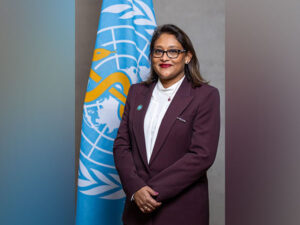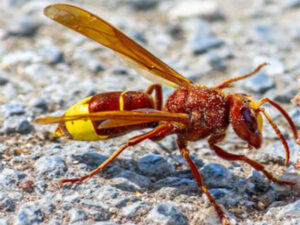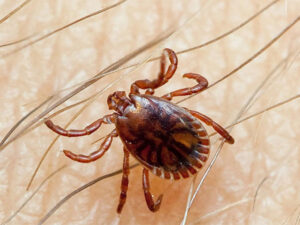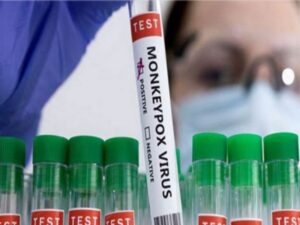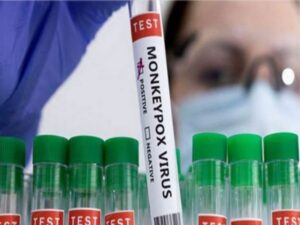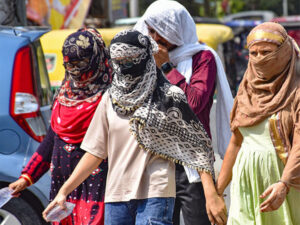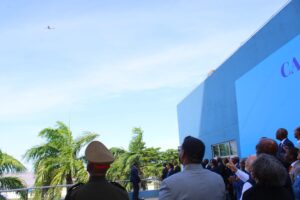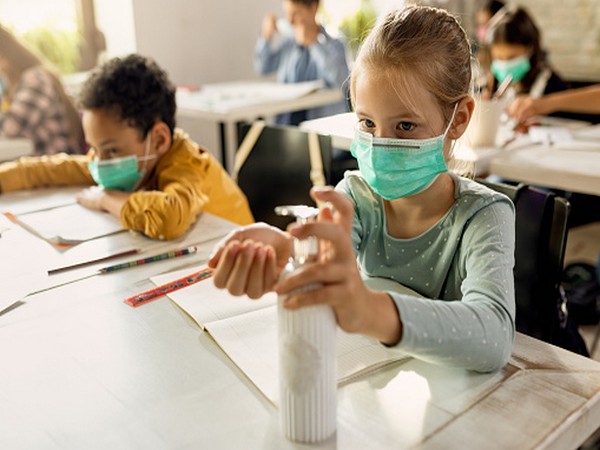
Schoolgirl with face mask using hands sanitizer while sitting at a desk in the classroom.
Washington [US], March 20 (ANI): In-school COVID-19 transmission is rare – even among close school contacts of those who test positive for the virus – when schools heed public health precautions such as mandatory masking, social distancing and frequent hand-washing, according to results of a pilot study in Missouri.
The study was aimed at identifying ways to keep elementary and secondary schools open and safe during the pandemic. Close contact is anyone who has been within 6 feet for more than 15 minutes in a 24-hour period with someone infected with COVID-19.
The study is part of a larger, ongoing collaboration involving the Centers for Disease Control and Prevention (CDC), Washington University School of Medicine in St. Louis, the Missouri Department of Health and Senior Services, the Missouri Department of Elementary and Secondary Education, Saint Louis University, the Springfield-Greene and St. Louis County health departments, and school districts in St. Louis and Springfield, Missouri areas.
The findings are published March 19 in the CDC’s journal, Morbidity and Mortality Weekly Report. The Missouri school findings mirror those of schools in other states, demonstrating that COVID-19 prevention efforts can significantly curb the spread of SARS-CoV-2 among students, teachers and staff.
“This work is imperative because keeping kids in school provides not only educational enrichment but also social, psychological and emotional health benefits, particularly for students who rely on school-based services for nutritional, physical and mental health support,” said senior author Johanna S. Salzer, DVM, PhD, a veterinary medical officer with the CDC’s National Center for Emerging and Zoonotic Infectious Diseases.
The pilot study involved 57 schools in the Pattonville School District in St. Louis County and the Springfield Public School District in Greene County in southwest Missouri, as well as two private schools in St. Louis County. All schools in the pilot study required students, teachers, staff and visitors to wear masks while on campus or buses.
Other safety measures included a focus on hand hygiene, deep cleaning of facilities, physical distancing in classrooms, daily symptom screenings for COVID-19, installing physical barriers between teachers and students, offering virtual learning options, and increasing ventilation.
For two weeks in December, the schools involved in the pilot project notified the research team of students, teachers and staff who were either infected with COVID-19 or quarantined due to being considered a close contact of someone who had tested positive.
In St. Louis, close contacts of students or teachers who had tested positive were placed in quarantine, meaning they were not to leave their homes for 14 days from when last exposed to a positive case. In Springfield, however, some of the close contacts of those who had tested positive were placed in modified quarantine – meaning they could stay in school if they and the infected person were wearing masks when in close contact; in this scenario, the infected person still isolated at home.
Participants in the pilot study included 193 persons across 22 of the 57 schools — 37 who tested positive for COVID-19 and 156 of their close contacts. Among participants who were COVID-19 positive, 24 (65 per cent) were students, and 13 (35 per cent) were teachers or staff members. Of the close contacts, 137 (88 per cent) were students, and 19 (12 per cent) were teachers or staff members.
Among the 102 close contacts who agreed to testing for COVID-19 using saliva tests, only two people received positive test results indicating probable school-based SARS-CoV-2 secondary transmission. Further, no outbreaks were identified in participating schools despite the high rates of community spread in December, even among the Springfield schools that followed modified quarantine protocols allowing some close contacts of positive individuals to remain in school.
“Schools can operate safely during a pandemic when prevention strategies are followed,” said one of the study’s leading researchers, Jason Newland, MD, a Washington University professor of paediatrics, who treats patients at St. Louis Children’s Hospital. Newland led the pilot program with the CDC and has advised multiple school districts in Missouri on plans for reopening schools. “The pilot study demonstrates low transmission in schools and no student-to-teacher transmission — and this was during the height of the pandemic in December, with high rates of community spread.”
Added Randall Williams, MD, director of the Missouri Department of Health and Senior Services: “Schools with proper prevention strategies remain a safe environment for students and teachers during the pandemic.” (ANI)






